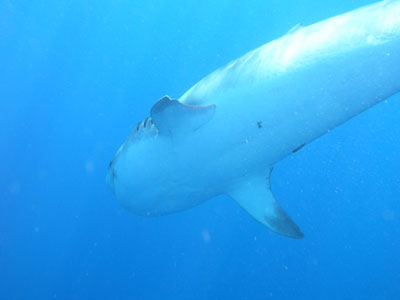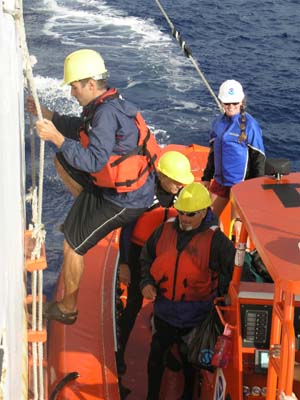|
You
are here: /main/research
expeditions/ 2005 RAMP/9_25_05
Shark barf
9/25/05
- Shark barf
by
David Nichols, State of Hawaii, DLNR, HIHWNMS

Chief scientist Randy Kosaki follows
a 12 foot tiger shark that has just been tagged and released.
Until today, I was under the impression that the vilest smell
on this planet was the odor that emanates from rotting whale
carcasses. I’ve experienced this stench up close and
personal. In the course of my job duties, I (along with the
help of many others) occasionally respond to dead whales washed
up on the beach. Marine mammal carcass disposal is not a glamorous
job -- but very necessary. A rotting whale carcass on the
wrong beach in Hawaii has the potential to spoil entire vacations.
Decaying whale blubber is very greasy and oily. It is absorbed
(along with the stink) into the skin and is nearly impossible
to wash off. The stink lasts for days and you never get accustomed
to it. You sleep alone. You are even too disgusting for your
dog to hang out with you.
Today,
“whale stink” would have been like a big bowl
of potpourri compared to what we were exposed to. I would
have curled up in the belly of a large rotting whale carcass
in order to avoid the stench that permeated the air surrounding
our boat. I was again looking for a scuba tank and regulator
simply to get a quick breath of useable air. The source of
today’s stench? It came from deep within the gut of
a thirteen-foot female tiger shark.

A tiger shark swims away after being implanted with
an acoustic transmitter (notice the incision with a single
stitch in the abdomen).
As
the shark team was pulling in the longline that they had set
earlier in the morning they came across their second hooked
tiger shark of the day. The first large male was measured,
tagged, implanted with a transmitter and released without
incident. As the second one was being maneuvered into position
alongside the HI-2 we noticed it regurgitate a large amount
of what looked like motor oil. We watched with fascination
as the large cloud of oil droplets slowly rose to the surface.
Once the oil droplets broke the surface, our fascination turned
quickly to queasiness. The odor was intense - an order
of magnitude higher than “whale stink” -
though it was vaguely familiar. It was almost as if the shark
had spent the last couple of weeks feeding on a rotting whale
carcass and was finally finishing up its digestive processing.
All that was left was the juice.
The
team fought back the urge to do some regurgitating of their
own and continued with the measurements, tagging and transmitter
placement as we drifted along in this large repugnant oil
slick. If only there was some way to capture this disgusting
fluid. Imagine the possibilities…

Kosta Stamoulis climbs aboard the Hi`ialakai from
the HI-1 as Richard Osada, Greta Aeby and Darla White wait
their turn.
Note:
I realize that many of the updates so far have focused on
the apex predator (i.e. shark) team. There is much more research
going on during this cruise -- research on algae, fish, corals
and other invertebrates. Also, the crew on board the Hi`ialakai
work extremely hard and are dedicated to supporting the science
teams and fulfilling project objectives. I intend to focus
future updates on these other aspects of the cruise just as
soon as the shark team has an uneventful day.
Return
to Expedition main page
|